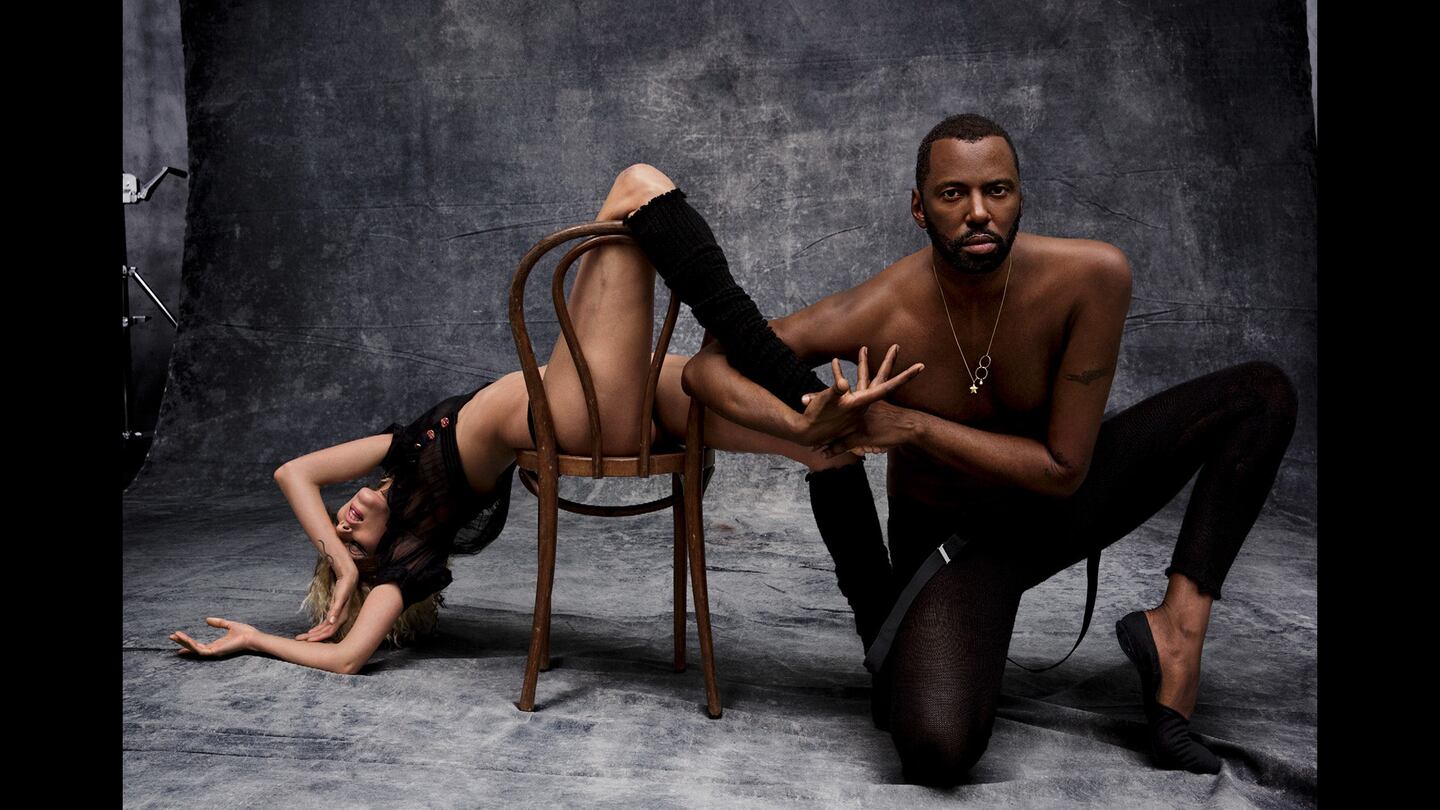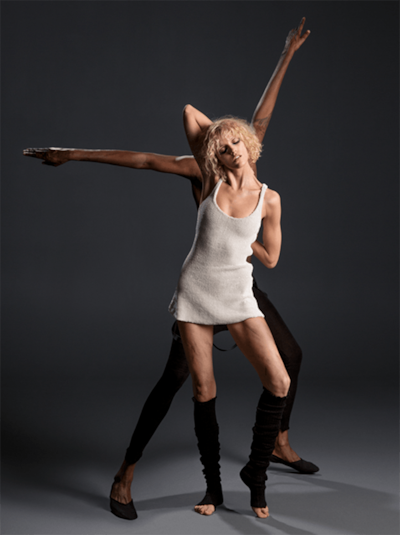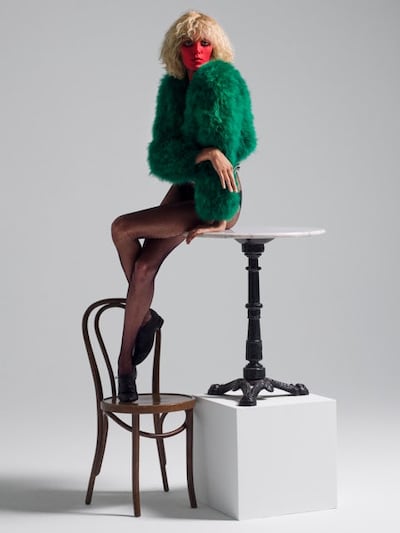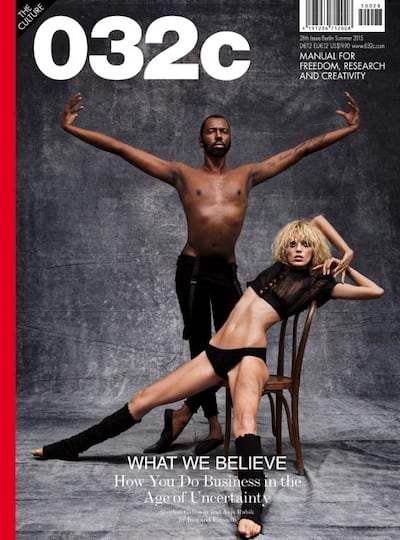
The Business of Fashion
Agenda-setting intelligence, analysis and advice for the global fashion community.

Agenda-setting intelligence, analysis and advice for the global fashion community.

NEW YORK — Stephen Galloway is obsessed with Diana Ross’s behind. Drinking a bloody Mary in Manhattan’s NoMad Hotel, the 48 year old dancer pores over a 1977 picture shot by Victor Skrebneski for the album Baby, It’s Me, in which the singer poses with her back to the camera, dressed in a slinky metallic gown.
She looks up at the light above her, a potent blast of disco firmament that bathes her divine silhouette. Galloway cannot tear himself from his phone. He is checking the status of a print he is trying to buy of the iconic black-and-white picture. Apart from the glamour it oozes, for Galloway, the picture captures the optimism of an era.
“I find myself referencing the 70s a lot, and trying to figure out why that is. I think the music was good, and there was a certain freedom. People were curious. There was still the idea of the future. We are so confronted with the immediacy of the present now that people don’t think about the future anymore. We’ve lost the excitement of, ‘What I can become?’ Or, ‘What is still to come in my life?’ Or, ‘Yeah, this is great, but wait till the 90s are here!’”
One of the six tattoos on Galloway's body spells the word HOPE, and the anticipation of a new, sexier tomorrow has not failed to inform his own trajectory. As a six-foot-four teenager, he left Erie, Pennsylvania for the industrious midlands of Germany, where he arrived in 1986 as ballet Frankfurt's youngest principal dancer.
ADVERTISEMENT
For almost two decades, Galloway was the star of what became — under the visionary choreographer William Forsythe — the most progressive classical dance company in the world. But even before Ballet Frankfurt's final performance in 2004, Galloway had started to carve out parallel careers straddling fashion, music, and visual culture.
There's another fact that helps explain why Galloway loves the Diana Ross photo so much. It's all sinuous line. And, more importantly, it's all back — a body part that happens to interest Galloway more than any other physical feature (except for, perhaps, an elongated neck).
“For me it’s all about the back of a shoulder, or the underpart of a neck. And I am always super concerned with the back.”
Galloway’s anatomic infatuation is key to the special niche that he has now come to occupy within the competitive world of high-end image-making.
In Skrebneski's shot, the erstwhile Supreme dramatically exaggerates the arch of her spine, while the precise lighting accentuates every contour of her hyper-defined shoulder. Thus the image captures a moment that is technically static — with no actual movement shown or suggested — yet conjures the impression that the human figure at its center is about to turn.
The work’s power lies in that conceit, a game of nuance that Galloway has turned into a job.
In 2002, Inez van Lamsweerde and Vinoodh Matadin invited Galloway, who was then at the peak of his dance career, to collaborate with them on an assignment for Calvin Klein in New York. The brand had enlisted the Dutch photographer couple — along with the graphic design studio M/M — to reinvigorate its image with a fresh advertising campaign featuring model Jessica Miller.
For the task, van Lamsweerde and Matadin asked Galloway to create “a whole new physical language, a new vocabulary of movement and fashion positioning.”
ADVERTISEMENT
It marked the beginning of Galloway's second career — or third, or fourth, depending on what how one counts. Since 1997, he has been a special consultant to the Rolling Stones, advising Mick Jagger and his bandmates on how to move on stage. He has also designed costumes for opera and ballet productions around the world.
Galloway had already been involved with fashion, art directing shows and special projects for a number of design houses, most notably for Issey Miyake in the 90s, but it is the specific vocation that began with the Calvin Klein job that today occupies the bulk of his time and provides him with the most satisfaction.

Neither choreographer nor coach, Galloway refers to what he does as “creative movement direction.” In addition to his work with van Lamsweerde and Matadin, he has worked with other leading fashion photographers and for an array of fashion magazines and labels.
“I bring a three-dimensional, sometimes four-dimensional, roundness to a flat image. It’s about making a person move, even if they are standing still.”
Put in more tangible terms, Galloway instructs supermodels and celebrities on how to pose, walk, jump, and roll around for the camera with a maximum awareness of their bodies. Depending on the job, Galloway's directives may maximize Gisele bündchen's mid-exhale magnetism, multiply Karlie Kloss's thoroughbred athleticism, or persuade a near-naked Rihanna to abandon herself in a quasi-feline solo romp. As Galloway describes in a recent shoot with the barbadian singer, the process involves equal measures of discipline and play.
“It was a physical dialogue, a tango of sorts. Rihanna is very smart and understood that it was about us getting confused in each other – not really knowing who is leading and who is following. I like it that way. It keeps me honest.”
Dubbed “The Model Whisperer” by The Wall Street Journal, Galloway invariably delivers the moments of engineered serendipity that every photographer is after. While working with a subject can involve him actively demonstrating moves and positioning body parts, Galloway’s guidance sometimes occurs in a mysterious language of nods, looks, or other minute gestures.
However, in every case, there is a moment when a silent rapport grows between Galloway and the person being photographed. Trust and an environment of minimal self-consciousness are requisite ingredients for his work. The reason why a growing number of top brands think that some of the best-paid photographers, models, and actresses on the planet could still benefit from the presence of a self-described “giant black guy standing in the corner,” can only be explained in terms of the unique vantage point Galloway brings to a shoot.
ADVERTISEMENT
“Of course a photographer knows all the possible placements for a set of hands. But I see things differently. I see the negative space around it, and I always see things in motion.”
According to Galloway — aside from his people skills, focus, and intuition — the answer lies in his gift for improvisation, which is a direct result of his years with ballet Frankfurt.
“It was like being in a laboratory with some of the greatest scientists in the dance world, the most gifted dancers of a generation. And it influences everything I do today. I was raised to walk into a room and do a dance with whatever I found. That’s how we worked, always looking at what’s around, underneath and on top of what you see, never taking anything at face value, always tilting it and turning it to its side before looking at it. It gives you a different frame of mind.”
Working under Forsythe in a think-tank of avantgarde dance instilled Galloway with a curiosity and an insistence on looking at things from a different angle that have found a seamless application in fashion, an industry that is chronically hungry for the new.
“When I am on set with photographers, like Inez and Vinoodh, I am trying to not only see what they’re seeing before they see it, but to also always ask the question: why they are seeing it? And for what reason? Billy [William Forsythe] taught me to be the most curious person in the room, and the person with the most expertise in the room at the same time. To know everything and absolutely nothing. That, to me, is ultimate freedom. And it’s where the magic of creating a great fashion image happens.”
Another factor that explains the growing demand for his services is Galloway’s innate physicality, perfected and intellectualized in his years as a dancer at the highest level. It allows him to connect and communicate with subjects in a way that even the best photographer would find difficult to achieve.
Galloway gets hired for the irreplaceable complicity he shares with people that, like himself, are trained to use their body as high-precision instruments. The best models and actresses, he says, have an awareness and command of their bodies that is akin to the physicality of a professional dancer.
“I really think it comes back to my understanding of the body, and of how a physical dynamic in a room can be altered – how the physical presence of a model, or of any person that is having their portrait taken, can be captured. It’s all about capturing. And sometimes that just means reminding the person to keep breathing. For example, Julianne Moore is like a ballerina. She perfectly understands the power that the arch of a back can have, or how expressive leaning this or that way, or looking over her shoulder just so can be.”
As part of the massive media blitz surrounding her album Vulnicura, Björk released the music video to "Lionsong" on March 12th of this year. Directed by van Lamsweerde and Matadin, the video had to capture the heartbreak of the song, yet undercut any overt sentimentality in keeping with the Icelandic singer's penchant for outlandish creativity.
The solution, in van Lamsweerde and Matadin’s minds, would be to make Björk appear “smooth like a spider waiting in her web and seductive like a balinese dancer cast in bronze.” Naturally, the photographers called on their dancer friend to create yet another fresh set of movements.
The 7-minute video was met with divided opinions. Some found it not innovative enough, while others deemed it excessively strange. Many think it is a masterpiece. but no commentary fails to point out the striking movement scheme Galloway came up with, which has Björk's limbs — digitally elongated to appear tentacular — flailing, waving, and air-hugging as she makes her way through the song's emotional lyrics. At times enticingly fluid, and at times jaggedly staccato, Galloway's choreography perfectly complements the haunting melody as well as the singer's varied register of expressions.
Though he didn’t officially start dancing till he was 13, Galloway says he has been dancing since he was born, thanks in no small part to his father’s sister. Notwithstanding the influence figures such as Ross, Forsythe, and Jagger have had on him, the person who has had the most lasting effect on Galloway may be his aunt Melba, who, according to Galloway, “Got the Red Hot Chilli Peppers all of their tattoos, and was buddies with Grace Jones when Grace met Dolph.”

Every Saturday, a pre-teen Stephen and his aunt would practice for the day. They watched Soul Train, the popular American television show featuring R&B, soul, and funk dancers. She took him to his first Prince concert when he was eleven, not without first warning him, “Listen, he’s going to be in women’s clothes, but don’t worry. That’s okay.”
Melba, who had studied in Europe, also alerted her young nephew to the existence of homosexuals — among which she had many friends — and to a whole fantastic world outside of the confines of Erie. Little did she know that Stephen, an avid Vogue reader and in total command of his body from an early age, was already aware of all this.
Soon, having received a classical training in his hometown, the long and ultra-limber teenage Galloway was off to Europe himself. He left the United States in part because of the negative impact Reaganomics had on the arts, but also to work with the likes of Maurice Béjart, Jiří Kylián, and the Stuttgart ballet. Instead, he ended up in Frankfurt, where Forsythe — at the time still relatively unknown — instantly offered him a job.
In Galloway, Forsythe found his ideal protégé. The famously cerebral choreographer regarded dance as a language, a semantic system with its own vocabulary and grammar. The point, however, was to break and upend these rules. Galloway’s fluid style, raw physicality, and quick wit provided Forsythe with a limber vehicle to give life to his theoretical compositions.
Pieces like the challenging Artifact — which Galloway says played to an empty house in ballet Frankfurt's early years and, toward the end, sold out every occasion it was performed — showcased the brilliant pairing of urbane prodigy and visionary mentor that helped make the company an international success.
While Forsythe may not physically be in the room when Galloway is directing models and actors (and even a few politicians) on how to move and pose for the camera, his radical frame- work of ideas is certainly present. The "fourth dimension" that Galloway says he adds to a fashion image is the logical extension of the non-verbal language he learned while working with the experimental choreographer — a body of knowledge and a knowledge of the body that Galloway carries with him wherever he goes.
“It’s a historical thing. It’s about information. It’s about knowledge. It’s about understanding the physicality of what your boundaries are and cannot be.”
One can still see the precocious kid who practiced for Soul Train every Saturday in Galloway's playful, charismatic, and overtly sensual personality. But his natural effervescence — as well as the ease experienced by everybody he comes in contact with — does not hide the extreme focus that is equally integral to his character. To wit, this Bloody Mary is his first drink after a month of rigorous abstinence for the sake of a packed work schedule.

Dancing, modelling, acting — to Galloway, it is all part of the same thing. Contradictions are essential to who he is. He knows everything and nothing. He is, simultaneously, the definition of laid-back as well as the product of extreme discipline. He can swerve from ferocious masculinity to flamboyant brio in a second. He goes with the flow and, at the same time, alters, controls, and reinvents that flow.
The only constants to Galloway’s world are presence, movement, and grace. but, as his ever-expanding résumé shows, there is a lot he can do with that.
This article is part of a special 32-page feature on Stephen Galloway, which first appeared in the Summer 2015 issue of 032c. The issue also includes an in-depth profile on FKA Twigs; a piece on Nike, Errolson Hugh and the future of urban tech-wear; and an interview with Instagram co-founder Mike Krieger.
In an exclusive extract from her new memoir ‘How to Make Herself Agreeable to Everyone’ the model and activist examines the dark side of the industry — and her complicity in it.
Brand architect and art director joins BoF founder and editor-in-chief Imran Amed to discuss the philosophy that underpins his groundbreaking retail and hospitality concepts.
Avery Trufelman, host of the fashion podcast “Articles of Interest,” joins BoF founder and editor-in-chief Imran Amed to discuss the multi-faceted layers behind the aesthetics of fashion.
The award-winning director of ‘High & Low: John Galliano’ tells Tim Blanks why the designer doesn’t expect forgiveness but would love a little understanding.